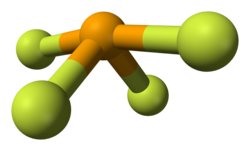Selenium tetrafluoride
Chemical compound From Wikipedia, the free encyclopedia
Selenium tetrafluoride (SeF4) is an inorganic compound. It is a colourless liquid that reacts readily with water. It can be used as a fluorinating reagent in organic syntheses (fluorination of alcohols, carboxylic acids or carbonyl compounds) and has advantages over sulfur tetrafluoride in that milder conditions can be employed and it is a liquid rather than a gas.
 | |
| Identifiers | |
|---|---|
3D model (JSmol) |
|
| ChEBI | |
| ChemSpider | |
| ECHA InfoCard | 100.033.352 |
PubChem CID |
|
| UNII | |
CompTox Dashboard (EPA) |
|
| |
| |
| Properties | |
| SeF4 | |
| Molar mass | 154.954 g/mol |
| Appearance | colourless liquid |
| Density | 2.77 g/cm3 |
| Melting point | −13.2 °C (8.2 °F; 259.9 K) |
| Boiling point | 101 °C (214 °F; 374 K) |
| Hazards | |
| NFPA 704 (fire diamond) | |
| Related compounds | |
Other anions |
selenium dioxide, selenium(IV) chloride, selenium(IV) bromide |
Other cations |
sulfur tetrafluoride, tellurium(IV) fluoride |
Related compounds |
selenium difluoride, selenium hexafluoride |
Except where otherwise noted, data are given for materials in their standard state (at 25 °C [77 °F], 100 kPa).
| |
Synthesis
The first reported synthesis of selenium tetrafluoride was by Paul Lebeau in 1907, who treated selenium with fluorine:[1]
- Se + 2 F2 → SeF4
A synthesis involving more easily handled reagents entails the fluorination of selenium dioxide with sulfur tetrafluoride:[2]
- SF4 + SeO2 → SeF4 + SO2
An intermediate in this reaction is seleninyl fluoride (SeOF2).
Other methods of preparation include fluorinating elemental selenium with chlorine trifluoride:
- 3 Se + 4 ClF3 → 3 SeF4 + 2 Cl2
Structure and bonding
Selenium in SeF4 has an oxidation state of +4. Its shape in the gaseous phase is similar to that of SF4, having a see-saw shape. VSEPR theory predicts a pseudo-trigonal pyramidal disposition of the five electron pairs around the selenium atom. The axial Se-F bonds are 177 pm with an F-Se-F bond angle of 169.2°. The two other fluorine atoms are attached by shorter bonds (168 pm), with an F-Se-F bond angle of 100.6°. In solution at low concentrations this monomeric structure predominates, but at higher concentrations evidence suggests weak association between SeF4 molecules leading to a distorted octahedral coordination around the selenium atom. In the solid the selenium center also has a distorted octahedral environment.
Reactions
In HF, SeF4 behaves as a weak base, weaker than sulfur tetrafluoride, SF4 (Kb= 2 X 10−2):
- SeF4 + HF → SeF3+ + HF2−; (Kb = 4 X 10−4)
Ionic adducts containing the SeF3+ cation are formed with SbF5, AsF5, NbF5, TaF5, and BF3.[3] With caesium fluoride, CsF, the SeF5− anion is formed, which has a square pyramidal structure similar to the isoelectronic chlorine pentafluoride, ClF5 and bromine pentafluoride, BrF5.[4] With 1,1,3,3,5,5-hexamethylpiperidinium fluoride or 1,2-dimethylpropyltrimethylammonium fluoride, the SeF62− anion is formed. This has a distorted octahedral shape which contrasts to the regular octahedral shape of the analogous SeCl62−. [5]
References
See also
External links
Wikiwand - on
Seamless Wikipedia browsing. On steroids.

